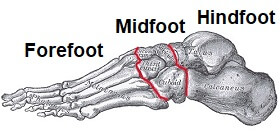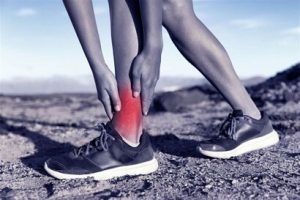 As the snow melts and we catch a glimpse of spring around the corner (hopefully), it’s time to get serious about our health goals. Whether it’s a 5k, a marathon, or just shedding some winter weight, running can be a great way to get and stay in shape and feel good about yourself. Unfortunately, running can also be harsh on your body, especially for a beginner. The injuries can pile up and sideline us from the sport, from rolled ankles to shin splints. We’ll review some tips to keep you healthy and on pace to reach your health goals.
As the snow melts and we catch a glimpse of spring around the corner (hopefully), it’s time to get serious about our health goals. Whether it’s a 5k, a marathon, or just shedding some winter weight, running can be a great way to get and stay in shape and feel good about yourself. Unfortunately, running can also be harsh on your body, especially for a beginner. The injuries can pile up and sideline us from the sport, from rolled ankles to shin splints. We’ll review some tips to keep you healthy and on pace to reach your health goals.
Avoid the Terrible Too’s of Training: Too Much, Too Hard, Too Fast
When runners first begin to see results and progress, it’s only natural to push the envelope. While this is a great way to challenge your mind and body, it is essential to understand that your body has thresholds. Exceeding these thresholds or preventing proper recovery is the quickest way to develop injuries.
New runners will want to keep a log to track their daily and weekly mileage. Some apps and devices, like Map My Run or Fitbit step counters, can help. Begin slow and steady; this is a marathon, not a sprint (pun intended).
The running community typically abides by The Rule of 10% – do not increase your mileage by more than 10% per week. This rule means if you ran 10 miles last week, don’t attempt to run more than 11 miles this week. While you may be able to handle the extra mileage mentally, the rule of 10 establishes guidelines so that your tissues can accommodate the additional physical stresses. Adding too much distance too quickly will likely result in an injury.
Where to begin? Some excellent Couch to 5k programs are geared to introduce running to someone who is just starting slowly. Be reasonable with your goals and training. If you haven’t run in years, don’t expect to be competing in a marathon within a few months. The body needs time to accommodate the stress you’re putting on it. Gradually increase your mileage while allowing adequate rest between.
No Pain, No Gain?
Most runners understand that there is some physical (and mental) pain that comes with the sport. Soreness in the legs or feet after a long run can =be expected, but significant pain levels while running should be an immediate red flag to take a break. While “pushing through the pain” may be tempting, a severe injury may await you. That knee pain may progress into more severe, longer-lasting, or even hip or foot pain. Listen to your body.
Remember to give your body time to heal. You’ll be hard-pressed to find a training outline recommending long run after long run. A typical schedule will have several short routes building up to a long run at the end of the week. That week is followed up by a few shorter runs before repeating with another long run. This regimen is purposefully designed to prevent severe injuries from occurring.
Cadence – Stride Length
New runners may not focus on more than putting one foot in front of the other. But as your running career lengthens, you may notice pain in the shins or recurring injuries to other body parts. New research suggests that the longer your stride length, the more impact your legs absorb from the ground. This force increase will create micro-traumas, eventually leading to more significant injuries. The solution? Shorten your stride and increase your steps.

Current recommendations suggest that runners land on the forefoot (the prominent area of your foot just before your toes) or midfoot. This landing pattern will naturally cause you to take shorter, quicker steps instead of long strides that pull your body forward. The shorter steps will exert less energy while propelling the runner forward. We understand everyone is different, and there is a wide variety of strides, but studies suggest a pace of about 180 steps/minute is ideal.
Current running research flies in the face of the conventional way many of us learned how to run. “Heel striking,” or landing on the hindfoot, is a relatively new running approach (new compared to the timeline of humankind). While this form of impact is natural while walking, it can be troublesome for a runner. Our foot has evolved to form a powerful arch that spans across the bottom of the foot. That dome is unique because it absorbs most impact while running (think of the shocks in your car’s suspension). However, heel striking doesn’t allow this tissue to absorb the shock and instead transmits the forces further up the kinetic chain (i.e., the knee or hip). “Running shoes” reinforce this idea by making taller and more cushioned heel pads.
To further emphasize how we should run, consider being barefoot as a child in the backyard. If you needed to walk across the yard casually, heel striking is a natural gait we’d select. However, if you were required to sprint across the yard to tag a friend, we’d change our mechanics to landing on the forefoot or toes. This change allows quicker acceleration and a faster pace while limiting the forceful impact through the ankles, knees, and hips.
Quick Tips
- Stay hydrated! This tip may sound like a no-brainer, but your body requires even more water when training regularly.
- Fuel your body with nutrients. Regular running can burn a significant number of calories. Ensure you’re replacing this energy with a diet of healthy fats, fruits, vegetables, and protein to aid your recovery.
- Don’t waste energy. Pay attention to your hands and arms when running. Some of us may unknowingly clench our fists while running. Closed-fist running wastes energy and blood flow to body parts that could use it during a run. Instead, keep your hands loose and slightly open. The analogy I’ve always heard is to pretend as if you’re holding two small birds in your palms.
- Cross-train. Diversity in your workout plan is vital to avoiding injury and burnout. Running daily allows your body to reinforce the running movement but nothing else. The rhythmic swinging of your arms and legs can create chronically tight muscles. Instead, incorporate different movements on your off days. Try activities like swimming, weight training, yoga, etc.
- Don’t forget to REST. As discussed earlier, avoiding injury is vital to not biting off too much mileage too quickly. But also allow these muscles you’ve been aggressively training to heal.
- Bounce back from the injury bug. Our next blog will dive into a little bit more of the specific injuries that runners can face and things to do to avoid them.
- Get an expert’s opinion. If you’ve followed the above directions but a nagging pain is limiting you from reaching your potential, set up an appointment with our office so that we can help you out. We specialize in analyzing and correcting the body’s biomechanics.
- **Most Importantly** – Have Fun! Running is a journey, not a destination. There is no endpoint but a rewarding path of learning about your body and mind. Endorphins (‘feel-good’ hormone) are released during running like nothing else. What may have begun as a New Year’s Resolution may evolve into the highlight of your day.
Whether seeking relief from chronic pain or simply aiming for optimal health, your Livonia chiropractor guides you every step of the way. Contact our office to schedule an appointment by Clicking Here or giving us a call today: 734-427-6333


